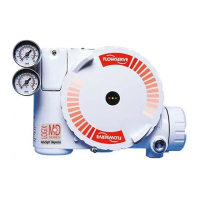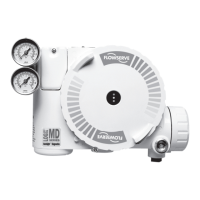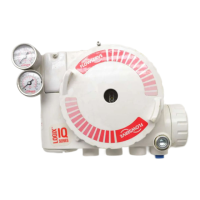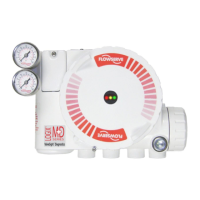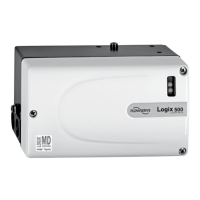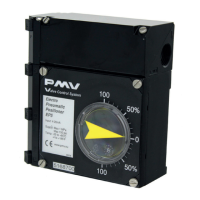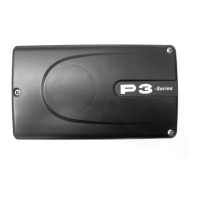5
Logix
®
420 Digital Positioner FCD LGENIM0106-07-AQ – 10/15
flowserve.com
characterization curve adjustments (including several Equal Percent), or
a 21-point Custom Characterization curve adjustment. In Linear mode,
the input signal is passed straight through to the control algorithm in
a 1:1 transfer. In Equal Percent (=%) mode, the input signal is mapped
to a standard rangeability equal percent curve. If Custom Characteriza-
tion is enabled, the input signal is mapped to a custom, user-defined
21-point output curve. The custom user-defined 21-point output curve
is defined using a handheld or ValveSight software. In addition, two
user-defined features, Soft Limits and Tight Shutoff may affect the
position. The actual command being used to position the stem after the
evaluation of characterization curves and user limits, is called the Final
Command.
1.12 Outer Loop
The Logix 420 uses a two-stage, stem-positioning algorithm. The two
stages consist of an inner-loop (pilot relay control) and an outer-loop
(stem position control). Referring again to Figure 1, a stem position
sensor provides a measurement of the stem movement. The Final
Command is compared against the Stem Position. If any deviation
exists, the control algorithm sends a signal to the inner-loop control to
move the relay in a direction, depending upon the deviation. The inner-
loop then quickly adjusts the spool position. The actuator pressures
change and the stem begins to move. The stem movement reduces the
deviation between Final Command and Stem Position. This process
continues until the deviation goes to zero.
1.13 Inner Loop
The inner-loop controls the position of the relay valve by means of a
driver module. The driver module consists of a temperature-compen-
sated hall-effect sensor and a Piezo valve pressure modulator. The Piezo
valve pressure modulator controls the air pressure under a diaphragm
by means of a Piezo beam bender. The Piezo beam deflects in response
to an applied voltage from the inner-loop electronics. As the voltage to
the Piezo valve increases, the Piezo beam bends, closing off against a
nozzle causing the pressure under the diaphragm to increase. As the
pressure under the diaphragm increases or decreases, the poppet valve
moves up or down respectively. The Hall effect sensor transmits the
position of the poppet back to the inner-loop electronics for control
purposes.
1.14 Detailed Sequence of Positioner
Operations
A more detailed example explains the control function. Assume the unit
is configured as follows:
• Unit is in Analog command source.
• Custom characterization is disabled (therefore characterization is
Linear).
• No soft limits enabled. No tight shutoff (MPC) set.
• Valve has zero deviation with a present input signal of 12 mA.
• Loop calibration: 4 mA = 0% command, 20 mA = 100% command.
• Actuator is tubed and positioner is configured air-to-open.
Given these conditions, 12 mA represents a Command source of 50
percent. Custom characterization is disabled so the command source is
passed 1:1 to the Final Command. Since zero deviation exists, the stem
position is also at 50 percent. With the stem at the desired position, the
poppet valve will be at a middle position that balances the pressures
and spring force in the actuator. This is commonly called the null or
balanced poppet position.
Assume the input signal changes from 12 mA to 16 mA. The positioner
sees this as a command source of 75 percent. With Linear charac-
terization, the Final Command becomes 75 percent. Deviation is the
difference between Final Command and Stem Position: Deviation = 75%
- 50% = +25%, where 50 percent is the present stem position. With
this positive deviation, the control algorithm sends a signal to move the
poppet up from its present position. As the poppet moves, the supply
air is applied to the bottom of the actuator. This new pressure differ-
ential causes the stem to start moving towards the desired position of
75 percent. As the stem moves, the Deviation begins to decrease. The
control algorithm begins to reduce the poppet opening. This process
continues until the Deviation goes to zero. At this point, the poppet will
be back in its null or balanced position. Stem movement will stop and
the desired stem position is now achieved.
1.15 Inner Loop Offset
The position of the poppet at which the pressure and springs are
balanced, holding the valve position in a steady state, is called the Inner
Loop Offset. The controlling algorithm uses this value as a reference in
determining the Piezo voltage. This parameter is important for proper
control and is optimized and set automatically during stroke calibration.
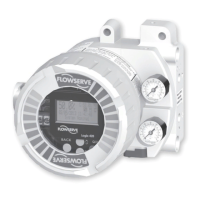
